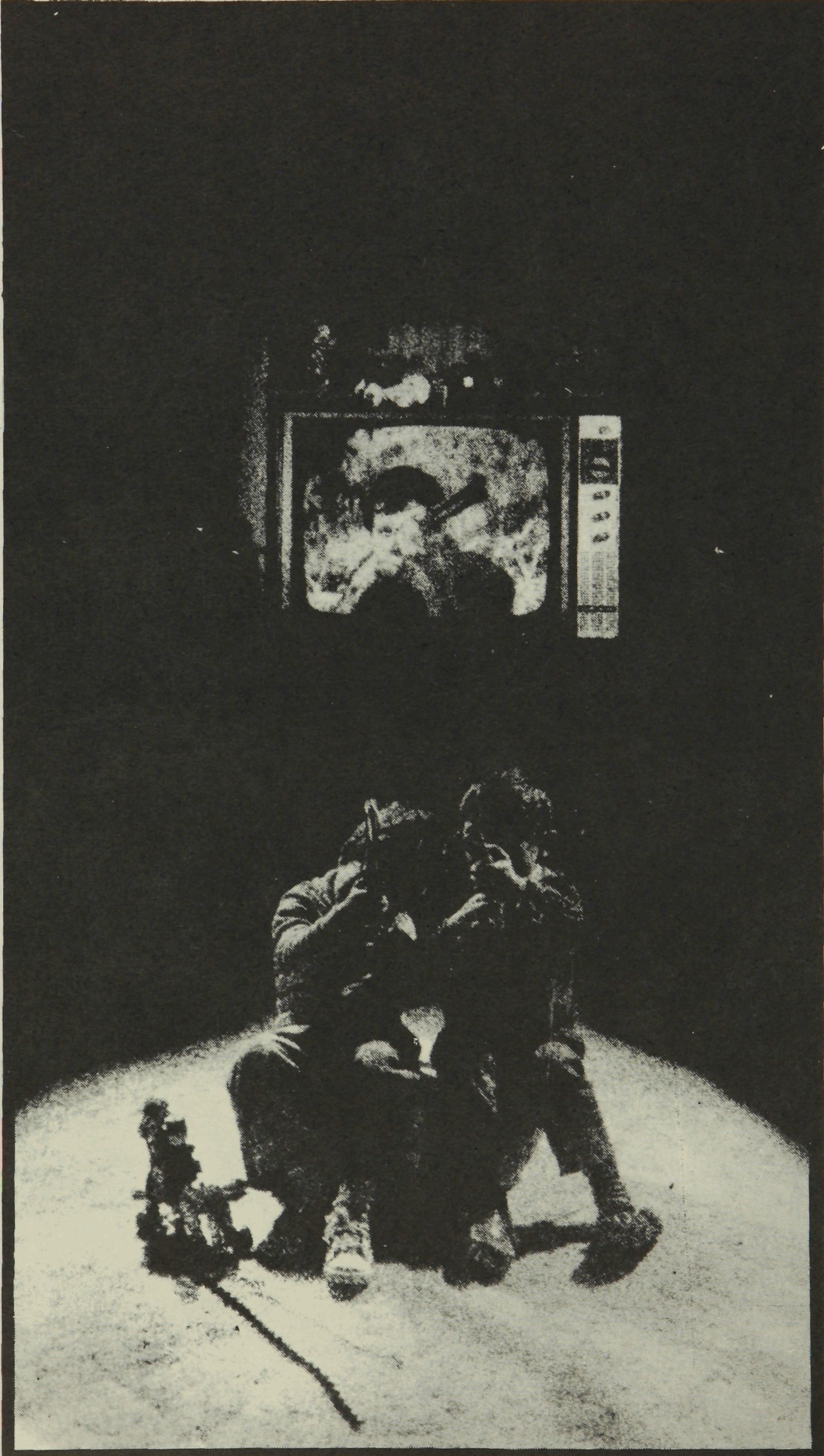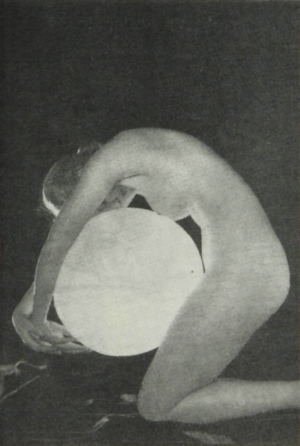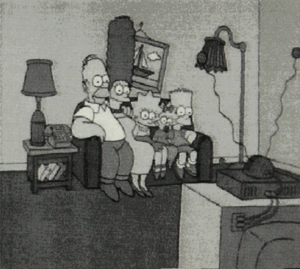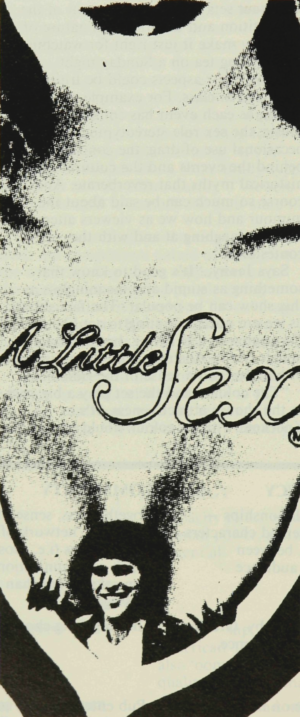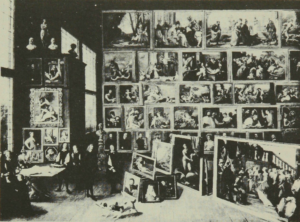As a Media Studies teacher of the very near future, I am concerned that I will have to respond to the steady diet of violence fed to my students by the mass media.
TV is, of course, the worst offender.
Look at the image of adult society presented to children in the most popular shows — the police dramas, action-packed war stories, super-hero adventures and horror films! In these shows, violence is not only frequent, but it is often justified and glamourized.
What is of particular concern to me is the fine line between reality and fantasy depicted on the screen. How do children differentiate between the two? And can they? It’s all very well saying that as children mature, they learn to interpret screen images. But what do you do until then? It is important to be able to discuss these popular shows and to break down the stereotyped violence so that children will learn to recognize the fantasy situations and not apply them to real life. This I hope will eventually lead to a greater understanding of every human’s rights regardless of sex, colour, age and background.
When I begin teaching, I do not see the point in getting the kids to make films about war or other similar violent subjects just for the sake of showing them how to use a camera or portapak. The actual subject matter becomes more important than the processes which they used to achieve their final results. I’m not saying that we shouldn’t ever make war or cop show type programs, but that we shouldn’t condone their already stereotyped views by our silence. It is important to point out to children exactly how and why violence is glamourized otherwise we are merely perpetuating those unreal examples of screen imagery which they see every day.
During the year, I spent a term on a teaching round at Huntingdale Tech. where I had a limited opportunity to put some of my ideas into practice.
I decided to run an elective called Special Effects and How to Get Them. I thought this would appeal to the interests of the kids, which it did. The people in the class ranged from Forms 1 to 3 and the classes consisted of 6 two-hour sessions. I brought along videotapes and films to spark off discussion and ideas.
My aims for the class were to show a series of films and videotapes illustrating how special effects are used in different types of films.
I intended to clarify some of these issues:
• What is a special effect?
• What is the difference between special effects and documentary footage?
• How special effects are constructed.
I then hoped to write a class script which must start with a series of special effects around which a storyline is added. Then we were to make the film, ensuring that the storyline did not take precedence over the special effects.
Finally I hoped to discuss the reasons why some film-makers rely so heavily on special effects. I hoped that our own little film production would throw some light on this discussion.
How often do teachers get kids to re-enact war and other violent stories just to maintain their interest long enough for them to produce a videotape or film. If this is the case we are then being just as irresponsible as those film makers who use elaborate special effects as a vehicle to sell their violent products. The context in which our Media skills are taught must never be sacrificed in order to achieve a videotape, super 8 film or even a series of photographs. Both are of equal importance.
Week 1: I showed the class a 20 minute Australian film from the Vincent Library entitled Beyond Fuller ($4.00 hire). This is a film based around a director in the ’50’s known as Samuel Fuller. His films were particularly violent and moralistic in their approach, as were many American films of that era. Beyond Fuller begins with the last few minutes of a Samuel Fuller film in which a man is shot rather gruesomely but somehow manages to stagger for what seems like miles (in a final example of true male strength) to his final resting place in an alley amongst the dirt tins. We then see the titles and realize that the film is being shown in a theatre. There is a young man seated in the theatre alone who now gets up to make his way home. Outside in the street he encounters someone who has presumably been mugged and killed. He then runs home to an almost empty room where the walls bear rather violent prints by well known artists. The other main feature of the room is a television set which is playing a news sequence from the Vietnam war. It shows the last few minutes of a Vietnamese man’s life. He is being led down the street by some policemen to his place of execution where a police officer promptly pulls out a gun and shoots the man through the head. The camera keeps rolling. As the man falls to the ground, the blood is still spurting from the hole in his head.
When the film ended I opened the discussion by asking everyone about their reaction. We then began talking about special effects and all the different types which existed. We related these ideas to Beyond Fuller and to how the effects in this film were achieved. Then one boy said, “I bet I know how they did that special effect where that man gets shot through the head and we see all the blood shooting out. I bet they put a plastic hose next to the side of his head and then pumped red paint out of it.” I stopped him and asked the others if they thought that was how this effect was performed. Some nodded their heads in agreement and others weren’t too sure until one of the girls said, “That wasn’t an actor. That was a real person. I saw part of that on the news once.” I seized this opportunity to start them thinking about how confusing all these special effects could be. And why film makers tried to make them so real. For the first week I asked everyone to be particularly aware of any special effect which they saw or heard, either on TV, at the pictures, in a magazine, newspaper or on radio.
The rest of the films which I showed were recorded from TV on to videotape. I did not want specific films, just films which fitted into specific categories. Horror, science fiction and suspense.
Week 2: The Bride of Frankenstein was second on the list. During the film I asked everyone to write down as many special effects that they could spot. We compared notes at the end but this became a bit of a laugh as everyone picked up something different. At this stage I asked the kids to decide upon what type of film they were going to make. The general consensus of opinion was there wasn’t enough money to make lots of fabulous special effects so we should deliberately try to make ours bad. Lots of fishwire for wobby spaceships like some of the old Japanese science fiction movies. The class divided into groups and designed at least two special effects per group.
Week 3: Forbidden Planet was the third film I showed the class. Again they wrote down any special effects they saw. After the viewing we attempted to work out the way in which the more baffling effects were constructed, and how we could put them together granted we had no money. During these discussions we drew on our knowledge of popular films or TV programs we had seen or knew about. Programs such as Starsky and Hutch, Charlie’s Angels, (which brought up the area of sexism and how it operated in the films we had seen and also how it currently operates under the disguise of the so-called “liberated good-looking chick”) Earthquake, Towering Inferno and so on. I asked all the groups to bring along drawings with explanatory notes for the following week of their special effects.
Week 4: This week bore bad news as the following week was to be cancelled because of correction day. Being a student teacher at the school meant that I could not stay over my allotted time so I had to change my plans for the class. This left us with only one week in which to make the film so instead we had to spend the last week making a complete storyboard of our film.
The last film I showed was The Birds. The aim this time was to point out how effects were created through the camera and editing. A suspense film is the most obvious example to point these features out.
By this time everyone knew how their special effects were going to operate. It was now only a matter of adding the storyline. There were a few arguments between the girls and the boys over the numbers of men and women on the spaceship. Not to mention the battle which ensued over who would survive the flight to its final destination. Of course the boys suggested that none of the women ought to make it.
We then began discussing the storylines of well known films and TV programs. Jaws came under some very close scrutiny along with the Six Million Dollar Man. What began to emerge from the discussion was just how flimsy were the storylines of these selling screen packages. They began to realize special effects were heavily relied upon to sell these programs.
Week 6: This week was almost entirely spent on the construction of the storyboard which was eventually videotaped frame by frame. I felt that most of the class had taken in their stride the first steps to becoming discerning screen viewers.
Unfortunately this was where it had to end. I would have liked to make the film with the kids but time had run out. I know they were disappointed and I know we would have achieved much more had we been able to extend our work over a longer period of time.
For me this kind of work opens up many possibilities in areas where children have pre-conceived ideas which are not gained through direct experience but are merely regurgitated from a medium such as television, which is determined to uphold and perpetuate its stereotyped images of everyday life.
Newspapers like the Sun and the Herald can be used as a prelude to running the type of program illustrated above. By using news headlines as the basis for pointing out how violence is glamourized in this media. This would be a fantastic place to start working with kids who have literacy problems … after all how many people just read the headlines any way before turning to the sports section.
Another follow up from my program at Huntingdale Tech. would be to enter the realms of advertising, especially in connection to the way in which popular programs are sold prior to their screenings. Does the way in which the film or TV program is sold truly reflect its content? This would eventually lead away from violence and could go into the whole area of consumer education. The avenues are unlimited.
Media teachers must never lose sight of the context in which their skills are being taught. One is useless without the other. If we let children make films or videotapes about violence in which they merely imitate the images of the mass media, then we are merely assisting the media to further glamourize this violence.
